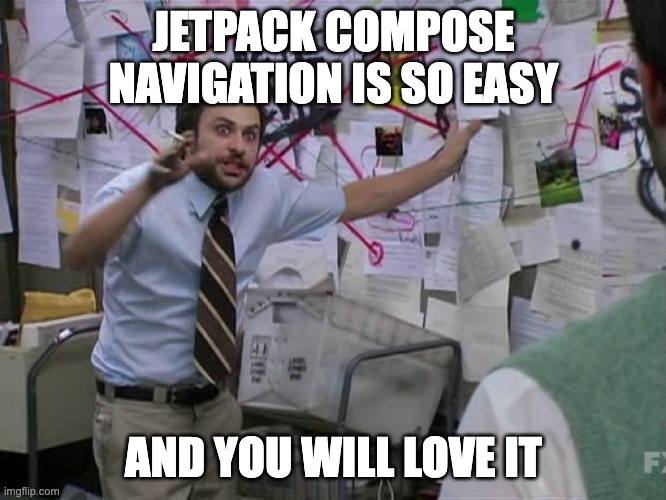Jetpack compose navigation
It’s Friday night! And you know what that means right? It’s time to dig deeper into Jetpack Compose. And today I would like to try out the navigation between screens with Jetpack Compose.
How hard can it?
Setup
Installing dependencies is never fun in an Android project.
First you need to find the libs.version.toml file and add these lines:
[version]
androidx-navigation = "2.7.7"
kotlinxSerializationJson = "1.6.3"
[libraries]
androidx-navigation-compose = { module = "androidx.navigation:navigation-compose", version.ref = "androidx-navigation" }
kotlinx-serialization-json = { module = "org.jetbrains.kotlinx:kotlinx-serialization-json", version.ref = "kotlinxSerializationJson" }
[plugins]
kotlin-serialization = { id = "org.jetbrains.kotlin.plugin.serialization", version.ref = "kotlin" }
Run gradle sync. Then open the build.gradle.kts within the app/ and apply the plugin and add the dependency
plugins {
// ...
alias(libs.plugins.kotlin.serialization)
}
dependencies {
// ...
implementation(libs.androidx.navigation.compose)
implementation(libs.kotlinx.serialization.json)
}
And then do another round of gradle sync.
If all went fine so far, then you’re all set for writing the code. If not, delete your project and start from scratch.
Implementation
Navigation in Android works with the help of these 2 components:
NavController: Top level object to navigate between screensNavHost: Container within which all routing happens.
So to make this work, we first need to inject the NavController at the root level of the app. Like say the MainActivity or the root composable like PhotoApp in our case.
fun PhotoApp(
navController: NavHostController = rememberNavController()
) { .. }
And then simply setup all the available routes
NavHost(
navController = navController,
startDestination = "home"
) {
composable("home") {
HomeScreen(
onSelectPhoto = { navController.navigate("photos/${it.id}") },
modifier = Modifier.fillMaxSize()
)
}
composable("photos/{id}") {
DetailScreen(
id = it.arguments?.getString("id") ?: "0",
modifier = Modifier.fillMaxSize()
)
}
}
And that is all there to it.
Thoughts
Now of course, one can go crazy with typed routing with sealed classes and what not. But this is the gist of it.
Just like React Native, the path arguments are by default string types and if there’s more data to be passed between the screens we need to come up with our strategy.
The good thing is the the back button comes for free with Android OS. But for custom back button we again need to devise our own tooling.
So there is how you navigate between screens with Android. The code for this experiment is up there sitting in the cloud nicely with the rest of the PhotoApp.
https://github.com/chunkyguy/PhotoApp/tree/master/kotlin
